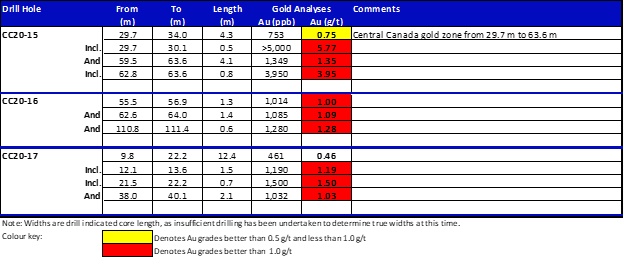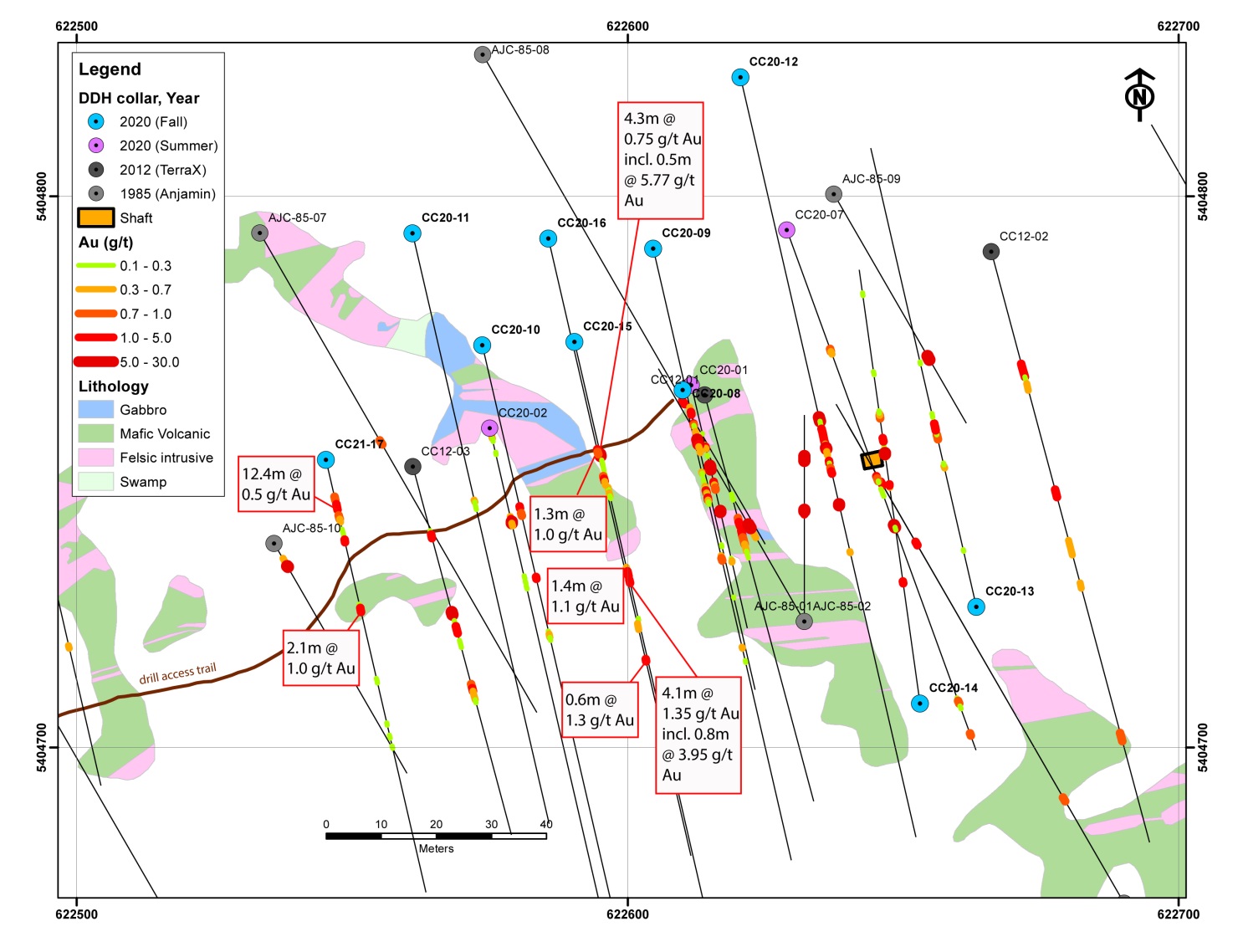Falcon Reports Gold Intersections in Holes CC 20 - 15, - 16, and - 17 at the Central Canada Mine Property, NW Ontario
VANCOUVER, BC / ACCESSWIRE / March 19, 2021 / FALCON GOLD CORP. (TSXV:FG)(GR:3FA)(OTC PINK:FGLDF); ("Falcon" or the "Company") is pleased to report the Company has received the preliminary gold analyses for drill holes CC 20 - 15, - 16 and - 17, summarized in Table One. The drilling of these holes took place December 12 to 21, 2020 and was the completion of the first year of Falcon's drilling on its flagship Central Canada property.
Mr. Karim Rayani, Falcon's Chief Executive Officer, commented, "We are very pleased with the results of the first round of drilling on the Central Canada gold project. The mineralization is proving to be quite robust - existing over a respectable strike length. Our next job will be to determine what geological structures control the high-grade sections and what may be the potential for the broad porphyry-hosted gold zones to be incorporated in the resource estimations."
Additionally, Falcon's geological team has completed re-examining the core from holes CC 20 - 04 to - 07 and has sampled several intervals of mineralized and altered felsic porphyries and volcanic rocks. Currently, the Company has delivered 168 samples to be assayed and these samples are the last batch from the 2020 drill program.
Table One. Summary of the of significant intersections of Falcon's 2020 drill holes, CC 20 - 15, 16 & 17 on the Central Canada gold project.
Drill holes CC 20 - 15, - 16 and - 17 totalled 471m, and were drilled south-south-east to target the main gold zone (Figure One, Table Two). Drill holes CC 20 - 15 and - 16 were drilled on the same south-south-east line approximately 30m west of the shaft. Both holes were inclined -45o with hole CC 20 - 16 stepped back from the collar of CC 20 -15 about 25m to the north. The gold mineralization similar in style to the Central Canada main gold zone was intersected in both holes. In hole CC 20 - 15, the interval from 29.7m to 34.0m averaged 0.75 g/t gold with the first 0.5m grading 5.77 g/t gold. The 4.1m interval beginning at 59.5m returned a grade of 1.35 g/t gold with the last 0.8m assaying 3.95 g/t gold. These gold-bearing intervals occur in strongly quartz-sericite-tourmaline-pyrite altered and veined felsic intrusive and felsic to mafic volcanic rocks. The intervals found in CC 20 - 16 appear to correspond with the zones in the above hole and may be indicating the continuity of the mineralization through the section.
Figure One. Surface level plan view of the 2020 drill program showing the Falcon, TerraX and Anjamin drill holes. Gold intercepts define a mineralized trend that includes the historical shaft. Note Falcon's hole CC 20 -17 results show an encouraging trend to the west.
Drill hole, CC 20 - 17 was collared 100m west of the shaft and drilled on an azimuth of 167o and inclined -45o. Three zones of gold mineralization were intersected between 9.8m and 40.1m and appear to correspond to the Central Canada main gold zone as presented in the above Table One. These results add continuity to the 275m strike length and depth >160m of the mineralized trend that has been intersected by the 2020 drilling program (See Figure 1).
Table Two. Location, azimuth, inclination, and length of Falcon's 2020 drill holes, CC 20 - 15, 16 & 17 on the Central Canada gold project.
QA/QC and Core Sampling Protocols
Samples collected in 2020-2021 were analyzed by Activation Laboratories, an ISO/IEC 17025:2017 accredited facility. Drill core was logged and sampled in Falcon's secure facility located near Atikokan, Ontario. Samples were obtained by cutting the core in half using a diamond cutting saw and were stored in Falcon's secure field office until their transportation by Falcon personnel to Activation Laboratories' sample preparation facility in Thunder Bay, Ontario. Gold was analyzed by fire assay with an Atomic Absorption finish; samples with >5 g/t Au were re-analyzed by fire assay with gravimetric finish. Certified gold reference standards, field duplicates and blanks were regularly inserted into the sample stream. Selected samples were also chosen for duplicate assay from the coarse reject of the original sample. Gold results from the holes reported herein varied from below detection to 5.77 g/t. No quality control/quality assurance issues were noted with the results reported herein.
Qualified Person
The technical content of this news release has been reviewed and approved by Stephen Brooking, P.Geo., who is a Qualified Person as defined by National Instrument 43-101, Standards of Disclosure for Mineral Projects.
About Falcon Gold Corp., the Central Canada Gold Mine Project, and Jack Lake Trend
Falcon is a Canadian mineral exploration company focused on generating, acquiring, and exploring opportunities in the Americas. Falcon's flagship project, the Central Canada Gold Mine, is approximately 20 km south east of Agnico Eagle's Hammond Reef Gold Deposit which has currently estimated 3.32 million ounces of gold (123.5 million tonnes grading 0.84 g/t gold) mineral reserves, and 2.3 million ounces of measured and indicated mineral resources (133.4 million tonnes grading 0.54 g/t gold). The Hammond Reef gold property lies on the Hammond shear zone, which is a northeast-trending splay off of the Quetico Fault Zone ("QFZ") and may be the control for the gold deposit. The Central Gold property lies on a similar major northeast-trending splay of the QFZ.
History of Central Canada gold mine includes;
1901 to 1907 - Shaft constructed to a depth of 12 m and 27 oz of gold from 18 tons using a stamp mill.
1930 to 1934 - Central Canada Mines Ltd. installed a 75 ton per day gold mill. Development work included 1,829 m of drilling and a vertical shaft to a depth of 45 m with about 42 m of crosscuts and drifts on the 100-foot level. In December, 1934 the mine had reportedly outlined approximately 230,000 ounces of gold with an average grade of 9.9 g/t Au.
1935 - With the on-going financial crisis of the Great Depression, the Central Canada Mines was unable to fund operations and the mine ceased operations.
1965 - Anjamin Mines completed diamond drilling and in hole S2 returned a 2 ft section of 37.0 g/t Au and hole S3 assayed 44.0 g/t Au across 7 ft.
1985 - Interquest Resources Corp. drilled 13 diamond holes totaling 1,840 m in which a 3.8 ft intersection showed 30.0 g/t Au.
2010 to 2012 - TerraX Minerals Inc. conducted programs that included line cutting, geological surveys and 363 m of drilling.
2020 - Falcon Gold Corp. completed its inaugural 17-hole program totaling 2,942.5 m of core.
The Company holds 5 additional projects. The Camping Lake Gold property and the Springpole West Property in the world-renowned Red Lake mining camp; a 49% interest in the Burton Gold property near Sudbury Ontario; and in BC, the Spitfire-Sunny Boy Gold Claims and the Gaspard property.
CONTACT INFORMATION:
Falcon Gold Corp.
"Karim Rayani"
Karim Rayani
Chief Executive Officer, Director
Telephone: (604) 716-0551
Email: info@falcongold.ca
Cautionary Language and Forward-Looking Statements
This news release may contain forward looking statements including but not limited to comments regarding the timing and content of upcoming work programs, geological interpretations, receipt of property titles, etc. Forward looking statements address future events and conditions and therefore, involve inherent risks and uncertainties. Actual results may differ materially from those currently anticipated in such statements.
Neither TSX Venture Exchange nor its Regulation Services Provider (as that term is defined in the policies of the TSX Venture Exchange) accepts responsibility for the adequacy or accuracy of this release.
SOURCE: Falcon Gold Corp.
View source version on accesswire.com:
https://www.accesswire.com/636474/Falcon-Reports-Gold-Intersections-in-Holes-CC-20--15--16-and--17-at-the-Central-Canada-Mine-Property-NW-Ontario